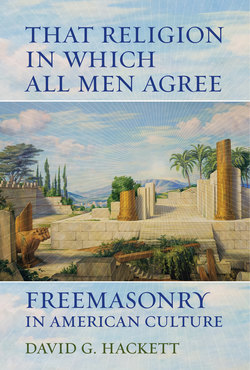That Religion in Which All Men Agree

Реклама. ООО «ЛитРес», ИНН: 7719571260.
Оглавление
David G. Hackett. That Religion in Which All Men Agree
Отрывок из книги
That Religion in Which All Men Agree
All Men Agree
.....
Timothy H. Breen first described this “religious public sphere” as “an intellectual space in which allegedly disinterested writers employing their reason in the name of the people might criticize and shape popular religious assumptions.”74 Beginning with the controversies that came to be known as the First Great Awakening, Americans engaged in public, print debates over religious matters. Frank Lambert has argued that the itinerant evangelist George Whitefield initiated these disputes by demanding that the forum for religious controversy be moved from the private, clerically controlled pulpit to the public arena of print, where literate men and women could make reasoned judgments and arguments.75 Accusations that the upstart evangelicals spoke in uncouth language while employing rhetoric and emotion rather than reason resulted in their making efforts to dispute in the language and reasoned logic of polite society.76 In moving from the private expression of religious convictions to public, printed efforts to persuade readers of the truth of their beliefs, writers on all sides of the issue learned to frame their arguments to appeal to the common sense of their readers. As the Boston antirevivalist John Caldwell warned, “Understand with your own Understanding; see Evidence before ye believe or judge.”77 Moreover, this paralleled ongoing secular debates over bank fraud and related issues, and in both cases, more and more colonial Americans adapted to polite society’s insistence that individuals make informed, well-reasoned decisions in an expanding marketplace of ideas.78
Whatever the character and significance of the American public sphere, it first appeared among the less than 5 percent of the population that lived in coastal cities.79 By the early eighteenth century, every major port city had at least one coffeehouse or tavern, which served as nexuses for extralocal news and information and, like elegant homes, a site for the new sociability. Within the decorum of this nascent polite society, strangers met, circulated manuscripts and published materials, engaged in and discussed literature and the arts, and entertained alternative visions of social and religious life. Gradually, a small but influential number of colonial elites fashioned a new and experimental realm of social life where they worked to bridge differences through civility and congenial conversation and find common cause in a wide variety of pursuits. Sheer joy, entertainment, and the members’ delight in one another’s company, David S. Shields has argued, were as much the purpose of these societies as any other motive. However, while providing a common ground of private pleasures for a coalescing upper class, they foreshadowed, with their multiple forms of communication and social relations, the emerging public.80 By the 1760s, this congenial realm of elegance and polish gave way to the sober reason and morality of a rapidly expanding public sphere, in which the new print media joined growing numbers of citizens in dialogue over questions surrounding revolutionary social change.
.....